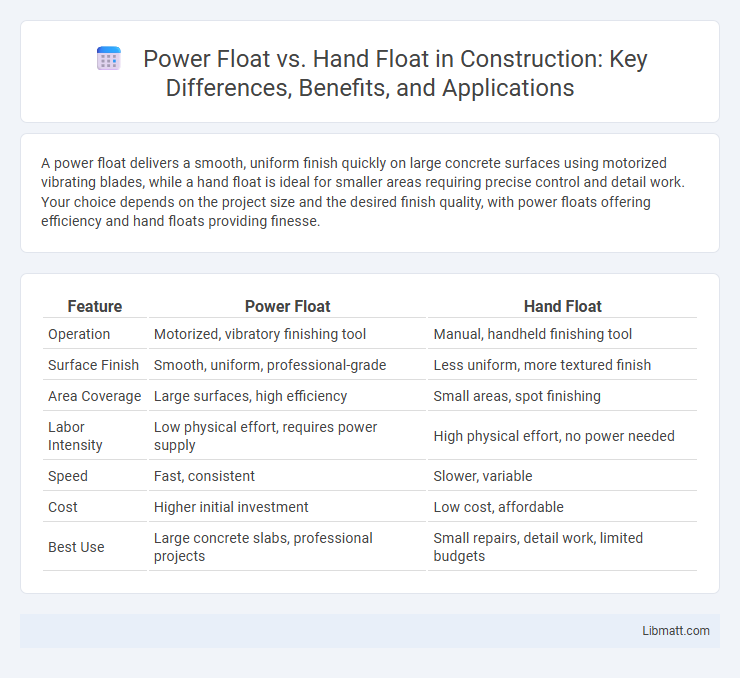A power float delivers a smooth, uniform finish quickly on large concrete surfaces using motorized vibrating blades, while a hand float is ideal for smaller areas requiring precise control and detail work. Your choice depends on the project size and the desired finish quality, with power floats offering efficiency and hand floats providing finesse.
Table of Comparison
| Feature | Power Float | Hand Float |
|---|---|---|
| Operation | Motorized, vibratory finishing tool | Manual, handheld finishing tool |
| Surface Finish | Smooth, uniform, professional-grade | Less uniform, more textured finish |
| Area Coverage | Large surfaces, high efficiency | Small areas, spot finishing |
| Labor Intensity | Low physical effort, requires power supply | High physical effort, no power needed |
| Speed | Fast, consistent | Slower, variable |
| Cost | Higher initial investment | Low cost, affordable |
| Best Use | Large concrete slabs, professional projects | Small repairs, detail work, limited budgets |
Introduction to Concrete Floating
Concrete floating is a critical process used to smooth and level freshly poured concrete surfaces, enhancing durability and preparing them for finishing. Power floats, or power trowels, are motorized machines designed for large slabs, providing efficient and uniform finishing with minimal labor. Hand floats, typically made of wood, magnesium, or aluminum, are manual tools ideal for small or intricate areas, offering more control but requiring greater effort.
What is a Power Float?
A power float is a machine used for finishing concrete surfaces, equipped with rotating blades that smooth and compact the material more efficiently than a hand float. It enhances surface flatness and density, resulting in a durable and professional finish ideal for large-scale projects. Using a power float can save you time and effort while achieving superior results compared to traditional hand-floating methods.
What is a Hand Float?
A hand float is a masonry tool used to smooth and finish concrete surfaces by hand, typically made of wood, magnesium, or aluminum with a flat, rectangular surface. It helps create a consistent texture, removes imperfections, and levels the concrete before it fully sets. Unlike power floats, hand floats rely on manual effort, providing greater control for detailed finishing on smaller or more intricate areas.
Key Differences Between Power Float and Hand Float
Power floats are motorized concrete finishing tools that deliver rapid, consistent surface smoothing, while hand floats rely on manual labor for detailed edging and surface leveling. Power floats cover large areas quickly, improving efficiency in slab finishing, whereas hand floats offer greater control for small or intricate sections. The key difference lies in speed and coverage, with power floats suited for expansive floors and hand floats ideal for precision work.
Advantages of Power Floating
Power floating offers faster and more uniform finishing results on concrete surfaces compared to hand floating, significantly reducing labor time and effort. Its motorized blades provide consistent pressure and smoothness, enhancing durability and surface quality for your concrete slabs. This efficiency makes power float machines ideal for large-scale projects where precision and speed are critical.
Benefits of Hand Floating
Hand floating offers precise surface control, allowing for detailed finishing in small or irregular areas where power floats may be too aggressive. This technique enhances surface texture, improving the bond strength of subsequent coatings or finishes. Its lightweight and maneuverability make it ideal for intricate work and reduce operator fatigue during extended use.
When to Use Power Float vs Hand Float
Power floats are ideal for large concrete slabs requiring a smooth, dense finish quickly, especially on commercial or industrial projects where time efficiency is crucial. Hand floats are better suited for smaller areas, achieving precise control and a finer finish in corners or tight spaces where machinery cannot reach. Your choice depends on the size and accessibility of the concrete surface, as well as the desired finish quality and project timeline.
Surface Finish Comparison
Power floats deliver a more uniform and denser surface finish due to their mechanical vibration and rotation, which consolidates the concrete more effectively than hand floats. Hand floats produce a rougher, less consistent texture, often leading to visible trowel marks and a less polished appearance. For large-scale concrete slabs needing a smooth, durable finish, power floats significantly improve surface quality and reduce labor time compared to manual hand floating.
Cost Implications and Efficiency
Power floats typically incur higher upfront costs due to machinery purchase or rental fees but offer significant labor savings by completing large concrete surface finishing jobs faster and with greater consistency. Hand floats, while much cheaper initially as manual tools, require more time and physical effort, leading to increased labor expenses on bigger projects and potential inefficiencies in achieving a uniformly smooth finish. Evaluating project scale and budget constraints helps determine whether the cost-efficiency of power floats outweighs their investment compared to the economy and slower pace of hand floats.
Choosing the Right Floating Method for Your Project
Selecting the right floating method depends on the scale and finish quality of your concrete project. Power floats are ideal for large slabs, providing a smooth, dense surface quickly, while hand floats offer greater control for smaller areas or detailed work. Understanding your project's requirements ensures that your concrete achieves optimal durability and appearance.
Power float vs hand float Infographic

 libmatt.com
libmatt.com